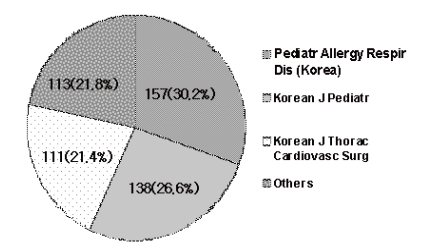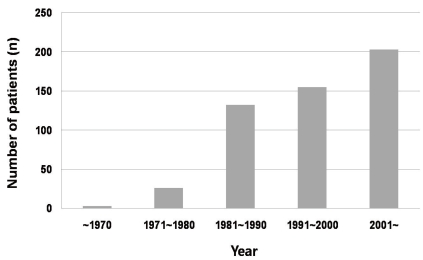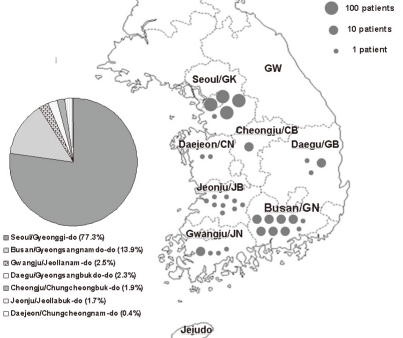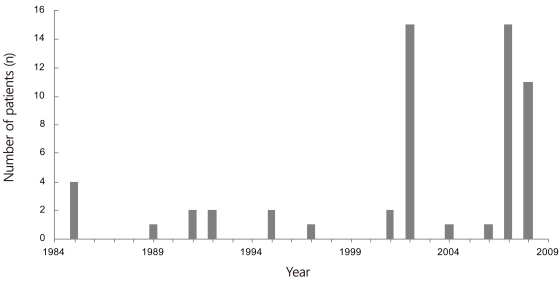Analysis of reports on orphan lung diseases in Korean children
Article information
Abstract
Purpose
Orphan lung diseases are defined as lung diseases with a prevalence of 1 or less in 2,000 individuals. Despite an increase in the numbers of patients with such diseases, few studies on Korean children have appeared. To obtain epidemiologic and demographic data on these diseases, we systematically reviewed reports on pediatric orphan lung diseases in Korea over the last 50 years.
Methods
We reviewed 223 articles that have appeared since 1958 on orphan lung diseases in Korean children. These articles described a total of 519 patients aged between 0 and 18 years. We classified patients by year of publication, diagnosis, geographic region, and journal.
Results
Of 519 patients, 401 had congenital cystic lung diseases and 66 had bronchiolitis obliterans. About 80% of patients were described in reports published in three journals, Pediatric Allergy and Respiratory Disease (Korea), the Korean Journal of Pediatrics, and the Korean Journal of Thoracic and Cardiovascular Surgery, in which papers on 157 (30.2%), 138 (26.6%), and 111 (21.4%) patients appeared, respectively. The frequency of publication of case reports has increased since 1990. Of the 519 patients, 401 (77.3%) were from Seoul/Gyeonggi-do and 72 (13.9%) from Busan/Gyeongsangnam-do.
Conclusion
The prevalence of pediatric orphan lung disease has increased since 1990, and some provinces of Korea have a higher incidence of these diseases than do others. Studies exploring the incidence of pediatric orphan lung diseases in Korea are needed for effective disease management.
Introduction
An orphan disease is a rare disease, with a frequency of 1 or less per 2,000 individuals. Around 7,000 orphan diseases have been reported throughout the world. Although the number of patients with any particular disease is small, the numbers of patients with orphan diseases are quite large. For example, about 6-8% of the entire population of Europe, or 27 million people, have an orphan disease1, 2). About 75% of patients with orphan diseases are infants, and about 30% of patients affected during infancy die before attaining the age of 5 years. Moreover, orphan diseases have a genetic component in about 80% of patients3). Thus, pediatric orphan diseases are an important component of national health policies and disease control.
Over the last several decades, with advances in imaging and diagnostic methods, the number of patients with orphan diseases has increased, emphasizing the need for systematic and comprehensive research. Because of the scarcity of individual diseases, research has been sporadic and management variable. In 1983, the United States enacted a law promoting research on orphan diseases. Also, since 1999, the European Community has introduced nation-based programs promoting health issues related to orphan diseases, and national governments and related institutions have begun to register and manage patients with such conditions2). Among institutions established for research on orphan respiratory diseases are the British Paediatric Orphan Lung Disease Registry (BPOLD) (www.bpold.co.uk) and the Children's Interstitial Lung Disease Foundation (www.childfoundation.info).
In Korea, the Orphan Intractable Disease Department at the Center for Disease Control and Prevention of the National Institutes of Health has (a) established an Orphan Intractable Disease Helpline (http://helpline.cdc.go.kr); (b) provided support for the medical expenses of patients with orphan diseases; (c) gathered statistics and epidemiological information on orphan diseases, and registered patients with these diseases; and, (d) established online consulting services. This Center is currently managing 421 kinds with orphan diseases, including respiratory conditions such as sarcoidosis and cystic fibrosis, although the Center does not handle patients with relatively well-known orphan diseases such as congenital cystic lung disease, primary ciliary dyskinesia, or obstructive bronchiolitis.
The symptoms of many pediatric orphan respiratory diseases are frequently expressed earlier than those of other orphan diseases, allowing prompt diagnosis and treatment of children and extending the life expectancy of such patients4, 5). Although epidemiological studies are the basis of early diagnosis and treatment, few epidemiological investigations on pediatric orphan respiratory diseases have appeared. In Korea, patients with such diseases have been described sporadically in relevant academic journals, and a national survey on pediatric acute interstitial pneumonia was conducted in 20096). Nevertheless, few programs for managing pediatric orphan respiratory diseases have been established and the number of reported systematic studies and investigations is low. To obtain epidemiologic and demographic data on pediatric orphan respiratory diseases in Korea, we systematically reviewed studies and case reports on such diseases published over the last 50 years. We intend to utilize these results in the early diagnosis and registration of patients with orphan respiratory diseases and to establish systematic disease control systems.
Subject and methods
1. Literature search
We searched the internet and academic journals for publications on orphan respiratory diseases reported in Korean children. Our initial work indicated that the Korean Journal of Pediatrics and the Korean Journal of Pediatric Allergy and Respiratory Disease were major potential sources of academic articles.
All issues of the Korean Journal of Pediatrics from 1992 to 2008 were searched using the homepage of the Pediatric Society (www.kjp.or.kr) and MedRIC (www.medric.or.kr), and issues from 1958 to 1991 were examined using printed journal copies. All issues of the Korean Journal of Pediatric Allergy and Respiratory Disease from 1991 to 2008 were searched using the homepage of the Pediatric Allergy and Respiratory Disease Society (www.kapard.or.kr). All reports on pediatric orphan respiratory diseases were extracted. Patients suffered from various conditions, including congenital anomalies, infections, malignancy, and hereditary diseases. To narrow the scope of our work, we focused on diseases covered by the BPOLD; reports on other diseases in small numbers of patients were considered separately. The BPOLD primarily provides information on and a registration service for nine pediatric orphan respiratory diseases; these are congenital cystic lung disease, congenital central hypoventilation syndrome, interstitial pneumonia, idiopathic pulmonary hemosiderosis, pulmonary proteinosis, pulmonary papillomatosis, bronchiectasis, pulmonary lymphangiectasis, and bronchiolitis obliterans. Using the disease names preferred by the Korean Journal of Pediatrics and the Korean Journal of Pediatric Allergy and Respiratory Disease as keywords, we searched other Korean journals using the websites of the Korean Academy of Medical Science Medical Information and Media Center (www.koreamed.org) and the Medical Research Information Center (www.medric.or.kr), and extracted papers describing diseases in children aged 18 years or younger. In total, we obtained relevant material from 24 academic journals including the Korean Journal of Pediatrics and the Korean Journal of Pediatric Allergy and Respiratory Disease. We sorted these reports by year of publication, institution, geographical area in which the patient lived, journal, research period, patient age, patient gender, and methods of diagnosis and treatment.
2. Data analysis
From the 24 journals, we extracted a total of 237 reports. Among these, 14 were redundant or were review articles, and were therefore excluded. Thus, 223 reports, describing 519 patients, were included in our analysis. These 519 patients were sorted according to journal, geographic area where medical center located in each studies, and date of publication. To gather geographic data, Korea was divided into nine provinces. With regard to date of publication, 10-year intervals were employed.
Congenital cystic lung diseases were divided into four categories based on pathological findings; the diseases were congenital lobar emphysema, congenital cystic adenomatoid malformation, pulmonary sequestration, and bronchogenic cysts. Patients with any of these four diseases were analyzed separately and included 30 prenatally diagnosed patients.
As no worldwide standardized classification system for pulmonary parenchymal diseases exists, we classified patients using the current recommendations of the American Thoracic Society and European Respiratory Society7).
3. Statistics
For each disease, we sorted patients by gender and age to obtain male-female ratios and means and standard deviations for each age group. Distributions with respect to journal of publication, date of publication, and geographic area are represented as percentiles.
Results
1. Literature classification
The 223 published reports on pediatric orphan respiratory diseases dealt with 519 pediatric patients, varying in age from prenatal to 18 years. After excluding some patients who were autopsied or for whom we had no age information, we found that the average age of patients was 58.3 months (±62.7 months). As gender was not reported for 57 patients, the overall male-female ratio is not known, but, of the 462 pediatric patients for whom gender was available, 270 (58.4%) were male. Of the 519 patients, 301 (58%) had congenital cystic lung disease, and the other conditions (in order of frequency) were bronchiolitis obliterans (66 patients, 12.7%), interstitial lung disease (56 patients, 10.8%), and bronchiectasis (49 patients, 9.4%). Among patients with congenital cystic lung disease, one also had pulmonary sequestration and bronchogenic cysts, and six additionally suffered from pulmonary sequestration and congenital cystic adenomatoid malformation (Table 1).
In our review of journals publishing relevant reports, we found that about 80% of patients were described in papers published in three journals, the Korean Journal of Pediatric Allergy and Respiratory Disease, the Korean Journal of Pediatrics, and the Korean Journal of Thoracic and Cardiovascular Surgery, in which reports on 157 (30.2%), 138 (26.6%), and 111 (21.4%) patients, respectively, appeared. The remaining 21 journals published reports on the residual 113 patients (21.8%) (Fig. 1).

Numbers and percentages of patients described in papers published in each journal. The highest number of patients was described in reports in Pediatric Allergy and Respiratory Disease (Korea).
By date of publication, we found that 29 patients (5.6%) were described before or in 1980, 132 (25.4%) in 1981-1990, 155 (29.9%) in 1991-2000, and 203 (39.1%) in 2000 or later, showing that the numbers of patients with pediatric orphan respiratory diseases has increased since the 1980s (Fig. 2).

Numbers of patients with pediatric orphan lung diseases reported in the last 5 decades. The incidence of these diseases has increased since the 1980s.
When we examined patient geographic distribution, we found that 401 (77.3%) were from the Seoul/Gyeonggi-do area, 72 (13.9%) from Busan/Gyeongsangnam-do, 13 (2.5%) from Gwangju/Jollanam-do, and 12 (2.3%) from Daegu/Gyeongsangbuk-do, with fewer than 2% of patients from the other five provinces of Korea (Fig. 3).

Regional distribution of pediatric orphan lung diseases in Korea. Most patients were from Seoul/Gyeonggi-do and Busan/Gyeosangnam-do. Abbreviations: GW, Gangwon-do; GK, Gyeonggi-do; CB, Chungcheongbuk-do; CN, Chungcheongnam-do; GB, Gyeongsangbuk-do; JB, Jeollabuk-do; JN, Jeollanam-do; GN, Gyeongsangnam-do.
2. First domestic report and numbers of reported patients based on BPOLD criteria
Among the pediatric orphan respiratory diseases included in this study, the most frequent disease within the BPOLD registration program was congenital cystic lung disease. Six patients with congenital central hypoventilation syndrome have been reported to date, with the first report published in 1993 in the Korean Journal of Pediatric Allergy and Respiratory Disease8). Of these six patients, five were neonates with congenital cystic lung disease accompanied by Hirschsprung disease; with one condition of unknown cause in a 4-month-old girl9).
Interstitial lung disease has been reported in 56 patients since 1985, and idiopathic pulmonary hemosiderosis in 7, with the first report appearing in 198510). Bronchiectasis was first described in 1993, with 49 patients reported in three journals to date; whereas bronchiolitis obliterans has been described in 59 patients since 1988. Pulmonary lymphangiectasis was reported in one patient, a 6-year-old girl, in 1998. Pulmonary proteinosis and pulmonary papillomatosis have been reported in Korean adults, but not in children (Table 1).
3. Other orphan respiratory diseases
Of the 519 pediatric patients with orphan respiratory diseases, 31 had conditions not registered in BPOLD, including 12 with paragonimiasis, 11 with primary ciliary dyskinesia, 6 with cystic fibrosis, 1 with a bronchial cast, and 2 with allergic bronchopulmonary aspergillosis. In terms of paragonimiasis, the first patient was reported in 1974. Four additional patients have been described since 2000. The first pediatric patient with cystic fibrosis was reported in 198811), and a total of six patients have been described to date; four boys and two girls; ranging in age from 2 days to 9 years. The first report of a patient with a bronchial cast, a 14-month old girl, appeared in 1988 in the Korean Journal of Pediatrics12). Of the two patients with allergic bronchopulmonary aspergillosis, one was described in 1999 and the other in 2000 (Table 1).
4. Congenital cystic lung diseases
The first Korean report on congenital cystic lung disease appeared in the Korean Journal of Pathology in 1961, describing the disease in seven fetuses, accompanied by an article on bronchogenic cysts and pulmonary sequestration, and describing sequestration and congenital cystic adenomatoid malformation in six patients13). Among patients with congenital cystic lung disease, 134 (44.5%) had congenital cystic adenomatoid malformation, 76 (25.2%) suffered from pulmonary sequestration, 64 (21.3%) had bronchogenic cysts, and 34 (11.3%) had congenital lobar emphysema.
Congenital lobar emphysema was reported in 8 patients between 1973 and 1990, in 15 from 1991 to 2000, and in 11 since 2000. Pulmonary sequestration was first reported in 196114), when the condition was described as intralobal pulmonary sequestration. In the interval since that time, 2 patients have been described in the 1970s and 29 in the 1980s, thus demonstrating a gradually increasing disease frequency. A bronchogenic cyst was first reported in 1961 in the Korean Journal of Pathology, and 64 pediatric patients have been reported to date. Congenital cystic adenomatoid malformation has been reported in 134 patients since 1969 (Table 1).
5. Interstitial lung diseases
Idiopathic pulmonary fibrosis has been reported in nine patients to date, including the first report of four patients in 198515), one in 1991, two in 1992, and two in 2002. Acute interstitial pneumonia has been reported in 17 patients; usual interstitial pneumonia (UIP) has been described in 2 individuals; 1 in 1991 and 1 in 2002; and desquamative interstitial pneumonia (DIP) has been reported in 3 patients, 1 in 1989 and 2 in 2002. The first report of nonspecific interstitial pneumonia (NSIP) was in 2002 in a 10-year-old girl16). Since that time, six further patients have been reported. Chronic infant pneumonia was first diagnosed in a 14-month-old girl17) in 2001, with six additional patients reported to date. Lymphocytic interstitial pneumonia (LIP) was reported first in 1997 in a 10-year-old girl18), and a second patient, a 14-year-old girl, was described in 2001. In 2002, two patients with cytomegalovirus pneumonia, one with histiocytosis, and one with lymphangiomatosis, were reported. Pulmonary sarcoidosis was first diagnosed in a 6-year-old girl19) in 2006, and bronchiolitis obliterans organizing pneumonia (BOOP) was first reported in an 11-year-old girl in 1995. A second patient with BOOP, accompanied by pneumonia, was described in 2002, and a third patient, in whom BOOP occurred after chemotherapy for AML, was described in 2004. Eosinophilic pneumonia was first found in a 6-year-old boy20) in 1995. Since 2000, the number of reported patients with interstitial lung diseases has tended to increase (Fig. 4).
Discussion
We analyzed 519 pediatric patients diagnosed with orphan respiratory diseases in Korea over the last 50 years by year of publication, geographic area, and journal. We found that pediatric orphan respiratory diseases in Korea have increased in frequency and diversity since 1980. We also found that the largest number of patients was from Seoul/Gyeonggi-do, compared with other geographic regions of the country.
The increase in frequency and diversity of pediatric orphan respiratory diseases is likely attributable to elevated rates of detection, arising primarily from advances in diagnostic technologies and methods, including improvements in medical equipment21). In particular, ultrasonography, high-resolution CT, MRI, bronchoalveolar lavage, and angiography enable early (even prenatal) prenatal diagnosis of diseases that were previously detectable only by autopsy or biopsy. Indeed, prenatal diagnosis and treatment at tertiary medical institutions resulted in a favorable prognosis for 38 pediatric patients with congenital cystic adenomatoid malformation22). We identified 24 additional patients, 10 in the 1990s and 14 since 2000, who were diagnosed prenatally and underwent surgery soon after birth, with good results.
When we assessed patients by geographic area, we found that 401 of the 519 pediatric patients with orphan respiratory diseases (77.3%) were from Seoul/Gyeonggi-do province, including the capital area. This is probably because 24 of the 44 (54.5%) general medical institutions in the country are in the capital area (2008, Ministry of Health and Welfare - www.mw.go.kr), and patients with long-lasting symptoms or ambiguous diagnoses choose or are transferred to a higher-level large hospital in the capital.
However, we found that six patients in Gwangju/Jollanam-do and six in Seoul/Gyeonggi-do were diagnosed with paragonimiasis. This is consistent with a previous report23), showing a high prevalence of paragonimiasis in the Jollanam-do area, Moreover, the prevalence of paragonimiasis in urban areas has been reported to be on the increase, because of an increasing number of tourists, population mobility, and the spread of regional food cultures24). Although improvements in the hygienic environment and hygiene campaigns have reduced the overall parasitic infection rate, from 6.7% in 199723) to 2.4% in 1997, the incidence of paragonimiasis has not decreased, because of ingestion of raw fish and salted crab. Indeed, we found that eight patients diagnosed with paragonimiasis had eaten salted freshwater crabs or taken raw crayfish juice. In contrast to other orphan respiratory diseases, paragonimiasis is preventable because the disease etiology is known. Thus, the disease incidence is expected to decrease further.
Interstitial lung diseases were reported in 56 patients, and the frequency increased over time, from 5 in the 1980s, to 12 in the 1990s, and 39 in 2000 and later. However, this apparent increase is likely not attributable to a real rise in incidence but rather to elevated concern about such diseases and a higher frequency of early diagnosis. Indeed, early diagnosis has been associated with a decreased dependence on open-lung biopsy and more frequent use of high-resolution CT in pediatric patients25). In Korea, the frequency of interstitial lung diseases in adults is about 7-10 per 100,000. In children, however, only a few reports have appeared since 1985, and epidemiological investigations have been limited to only a few of these diseases. Because of the limited amount of available data, we do not know the actual prevalence or male-female ratio of interstitial lung diseases in Korean children26).
Although pulmonary hemosiderosis is sometimes classified as an interstitial lung disease, depending on etiology7), we analyzed this disease separately, based on the BPOLD classification. All seven patients with pulmonary hemosiderosis presented with the three major symptoms of the disease: recurrent hemoptysis and dyspnea, iron deficiency anemia, and diffuse pulmonary infiltration on chest X-ray. Among these seven patients, five were male and two female.
Cystic fibrosis was reported in six patients in seven reports, with one report describing 15 years of follow-up of a boy with this disease who was first described in 1988. In all six patients, a cystic fibrosis transmembrane conductance regulator (CFTR) gene mutation was confirmed through genetic testing. Cystic fibrosis is a relatively common genetic disease in Caucasians, with a frequency of 1 per 2,000 persons, but is extremely rare among Asians, with a frequency, for example, of 1 per 350,000 persons in Japan27). As the genetic characteristics of Koreans are similar to those of the Japanese, the incidence of cystic fibrosis in Korea is also expected to be similar, making the number of affected patients larger than the number of reported patients.
In the present study we collected, classified, and analyzed pediatric patients with orphan respiratory diseases reported over the last 50 years. Although we observed changes in the incidence of these diseases, most papers were case reports, focusing on specific patients. Thus, we could not accurately determine the prevalence of the various diseases or adequately follow the clinical course of the patients. In addition, we cannot exclude the possibility that some reports may have described the same patients. Therefore, the number of patients reported may not be the real total.
Despite these limitations, however, our results indicate that the number of reported patients with pediatric orphan respiratory diseases is increasing in Korea. These results form a baseline for systematic and continuous orphan disease control, as occurs in the United States and Europe. Our findings also point to the need for more consistent and accurate epidemiological investigation and disease control in the future.

